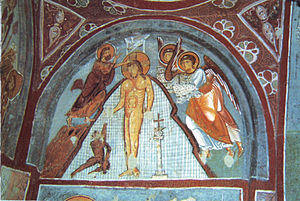
An old (1973) article in the Journal of Biblical Literature by Robin Scroggs and Kent I. Groff make a case that the young man who fled naked from the scene of Jesus’ arrest in Gethsemane and the young man (reappearing?) in the tomb to announce Jesus’ resurrection were originally created as symbols of the baptism ritual for new converts to Christianity.
The young man having his linen cloak (σινδόν / sindon) snatched from him is substituted by Jesus who is entering into his “baptism” of suffering, death and burial — as depicted by Jesus himself being wrapped in a σινδόν/sindon for burial. The young man then reappears in the tomb, sitting on the right side, clothed in white like Jesus at the transfiguration. These narrative scenes find their meaning in the baptism ritual of early Christians: the initiate first removed his garment and entered the baptism naked and was then given a new robe to symbolize a new life in the resurrected Christ. Continue reading “That Mysterious Young Man in the Gospel of Mark: Fleeing Naked and Sitting in the Tomb”
